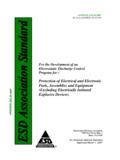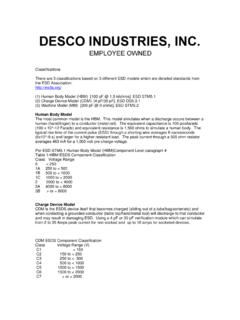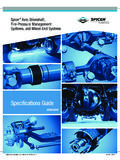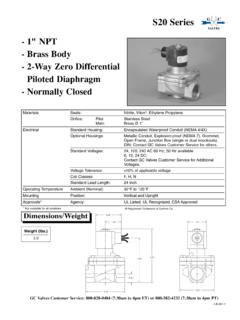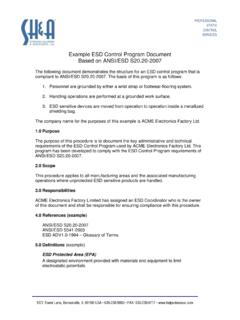Transcription of Protection of Electrical and Electronic Parts, …
1 ANSI/ESD Revision of ANSI/ESD For the Development of an Electrostatic Discharge Control Program for Protection of Electrical and Electronic Parts, Assemblies and Equipment (Excluding Electrically Initiated Explosive Devices) Electrostatic Discharge Association 7900 Turin Road, Bldg. 3 Rome, NY 13440 An American National Standard Approved March 1, 2007 ANSI/ESD ESD Association Standard for the Development of an Electrostatic Discharge Control Program for Protection of Electrical and Electronic Parts, Assemblies and Equipment (Excluding Electrically Initiated Explosive Devices) Approved February 11, 2007 ESD Association ANSI/ESD Electrostatic Discharge Association (ESDA)
2 Standards and publications are designed to serve the public interest by eliminating misunderstandings between manufacturers and purchasers, facilitating the interchangeability and improvement of products and assisting the purchaser in selecting and obtaining the proper product for his particular needs. The existence of such standards and publications shall not in any respect preclude any member or non-member of the Association from manufacturing or selling products not conforming to such standards and publications.
3 Nor shall the fact that a standard or publication is published by the Association preclude its voluntary use by non-members of the Association whether the document is to be used either domestically or internationally. Recommended standards and publications are adopted by the ESDA in accordance with the ANSI Patent policy. Interpretation of ESDA Standards: The interpretation of standards in-so-far as it may relate to a specific product or manufacturer is a proper matter for the individual company concerned and cannot be undertaken by any person acting for the ESDA.
4 The ESDA Standards Chairman may make comments limited to an explanation or clarification of the technical language or provisions in a standard, but not related to its application to specific products and manufacturers. No other person is authorized to comment on behalf of the ESDA on any ESDA Standard. THE CONTENTS OF ESDA S STANDARDS AND PUBLICATIONS ARE PROVIDED AS-IS, AND ESDA MAKES NO REPRESENTATIONS OR WARRANTIES, EXPRESS OR IMPLIED, OF ANY KIND WITH RESPECT TO SUCH CONTENTS.
5 ESDA DISCLAIMS ALL REPRESENTATIONS AND WARRANTIES, INCLUDING WITHOUT LIMITATION, WARRANTIES OF MERCHANTABILITY, FITNESS FOR PARTICULAR PURPOSE OR USE, TITLE AND NON-INFRINGEMENT. DISCLAIMER OF GUARANTY: ESDA STANDARDS AND PUBLICATIONS ARE CONSIDERED TECHNICALLY SOUND AT THE TIME THEY ARE APPROVED FOR PUBLICATION. THEY ARE NOT A SUBSTITUTE FOR A PRODUCT SELLER S OR USER S OWN JUDGMENT WITH RESPECT TO ANY PARTICULAR PRODUCT DISCUSSED, AND ESDA DOES NOT UNDERTAKE TO GUARANTY THE PERFORMANCE OF ANY INDIVIDUAL MANUFACTURERS PRODUCTS BY VIRTUE OF SUCH STANDARDS OR PUBLICATIONS.
6 THUS, ESDA EXPRESSLY DISCLIAMS ANY RESPONSIBILITY FOR DAMAGES ARISING FROM THE USE, APPLICATION, OR RELIANCE BY OTHERS ON THE INFORMATION CONTAINED IN THESE STANDARDS OR PUBLICATIONS. LIMITATION ON ESDA S LIABILITY: NEITHER ESDA, NOR ITS MEMBERS, OFFICERS, EMPLOYEES OR OTHER REPRESENTATIVES WILL BE LIABLE FOR DAMAGES ARISING OUT OF OR IN CONNECTION WITH THE USE OR MISUSE OF ESDA STANDARDS OR PUBLICATIONS, EVEN IF ADVISED OF THE POSSIBILITY THEREOF.
7 THIS IS A COMPREHENSIVE LIMITATION OF LIABILITY THAT APPLIES TO ALL DAMAGES OF ANY KIND, INCLUDING WITHOUT LIMITATION, LOSS OF DATA, INCOME OR PROFIT, LOSS OF OR DAMAGE TO PROPERTY AND CLAIMS OF THIRD PARTIES. Published by: Electrostatic Discharge Association 7900 Turin Road, Bldg. 3 Rome, NY 13440 Copyright 2007 by ESD Association All rights reserved No part of this publication may be reproduced in any form, in an Electronic retrieval system or otherwise, without the prior written permission of the publisher.
8 Printed in the United States of America ISBN: 1-58537-121-1 DISCLAIMER OF WARRANTIES CAUTION NOTICE ANSI/ESD i (This foreword is not part of ANSI/ESD ) FOREWORD This standard covers the requirements necessary to design, establish, implement and maintain an Electrostatic Discharge (ESD) Control Program for activities that manufacture, process, assemble, install, package, label, service, test, inspect or otherwise handle Electrical or Electronic parts, assemblies and equipment susceptible to damage by electrostatic discharges greater than or equal to 100 volts Human Body Model (HBM).
9 This document covers the ESD Control Program requirements and offers guidance for setting up a program to handle ESD sensitive (ESDS) items, based on the historical experience of both military and commercial organizations. References include ESD Association, Military and ANSI approved standards for material properties and test methods. The fundamental ESD control principles that form the basis of this document are: A. All conductors in the environment, including personnel, shall be bonded or electrically connected and attached to a known ground or contrived ground (as on shipboard or on aircraft).
10 This attachment creates an equipotential balance between all items and personnel. Electrostatic Protection can be maintained at a potential above a zero voltage ground potential as long as all items in the system are at the same potential. B. Necessary non-conductors in the environment cannot lose their electrostatic charge by attachment to ground. Ionization systems provide neutralization of charges on these necessary non-conductive items (circuit board materials and some device packages are examples of necessary non-conductors).
